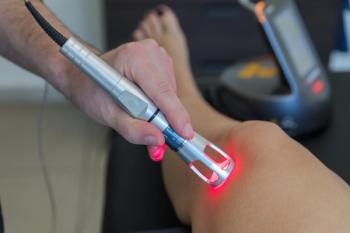
More new therapies under study for underarm sweat
Qbrexza was approved earlier this year for primary axillary hyperhidrosis. And, now, other treatments are under study. In his presentation at this week’s Fall Clinical Dermatology Conference in Las Vegas, Dr. David Pariser summarizes the latest research.
LAS VEGASâThe approval of the topical glycopyrronium tosylate (Qbrexza, Dermira) for primary axillary hyperhidrosis may soon be followed by other treatments for the condition, says David M. Pariser, M.D., FAAD, in a presentation made at the Fall Clinical Dermatology Conference taking place this week in Las Vegas.
“It’s really exciting that there is something new after a period of 12 years or so of drought in innovation,” said Dr. Pariser, of the Eastern Virginia Medical School in Norfolk, Va. “Not only is there something new, but there are several new things in the pipeline for patients.”
Dr. Pariser is secretary and founding president of the International Hyperhidrosis Society. He said that historically, hyperhidrosis prevalence has been estimated at approximately 2.8 percent of the U.S. population, but recent studies have increased that estimate to 4.8 percent.
ATMOS-1 AND ATMOS-2 TRIALS
Dr. Pariser presented results from the phase three ATMOS-1 and ATMOS-2 trials that showed results from 330 patients (9 years old or older with at least six months of axillary hyperhidrosis) randomized to receive glycopyrronium tosylate for four weeks. The primary endpoint was the absolute change in axillary sweat production from baseline and at least a four-point improvement in axillary sweating daily diary (ASDD) response.
At the study endpoint, 52.8 percent of patients in ATMOS-1 and 66.1 percent of patients in ATMOS-2 receiving glycopyrronium tosylate reported decreased sweat severity compared with 28.3 percent and 26.9 percent of patients in ATMOS-1 and ATMOS-2, respectively. There was also a significant decrease in the production of gravimetrically-measured sweat in patients receiving glycopyrronium tosylate. Of note, 31 patients reported unilateral mydriasis which resolved in 20 patients without interrupting the study; in seven patients, mydriasis resolved after drug intervention and four patients discontinued use due to mydriasis. Other adverse events included local skin reactions and dry mouth, which decreased as patients continued to take the drug.
“The long-term management of this drug, which we now have available, showed safety results consistent with anticholinergic results that we’ve seen from oral drugs,” Dr. Pariser said. “There were some adverse events to it, but it balanced out the efficacy in almost all the patients. I can tell you the patients in the clinical trial said [they’ll] be glad to have a little dry mouth to see the improvement.”
SOFPIRONIUM BROMIDE
Sofpironium bromide, a soft topical anticholinergic underwent a phase two trial last year, Dr. Pariser said. In the study, 227 patients from 23 different centers were randomized to receive once-daily sofpironium bromide 5 percent, 10 percent, 15 percent or vehicle for 42 days. Outcomes were measured by patient-reported outcome with the Hyperhidrosis Disease Severity Measure-Axillary (HDSM-Ax) score.
There were 75.9 percent of patients in the sofpironium bromide 15 percent group who had a grade one or greater reduction in HDSM-Ax from baseline compared with 70.2 percent of patients in the sofpironium bromide 5 percent and vehicle groups. Safety and tolerance with regard to adverse events in the phase two trial was similar to GT, in addition to a similarly high placebo effect in both the GT and sofpironium bromide trials, but “it remains to be seen when this goes to phase 3 the same thing will occur,” Dr. Pariser said.
THVD-102
THVD-102, a combination of 7.5 mg instant-release oxybutynin and 7.5 mg delayed-release pilocarpine, is another therapy tested against 7.5 mg oxybutynin and placebo in a recent investigation. “What happens if we take oxybutynin, an anticholinergic we’ve used systemically for a long time, and combine it with pilocarpine, which stimulates salivation through a different receptor? Could we then get rid of dry mouth?”
Investigators applied THVD-102 to the primary area of axillary hyperhidrosis in 17 patients and the palmar hyperhidrosis in six patients. Patients initially received oxybutynin for three weeks, with those who developed dry mouth proceeding into a crossover study where all patients received THVD-102, oxybutynin or placebo. There was a statistically significant improvement in Hyperhidrosis Disease Severity Scale score in the THVD-102 and oxybutynin groups; however, there were fewer cases of dry mouth when patients received THVD-102.
DISCLOSURES
Dr. Pariser is an investigator and consultant for Allergan, Dermira, Watson Labs, Brickell Biotech, Revance, a consultant for Ulthera and Anterios and Dermavant and an investigator for Atacama.
Newsletter
Like what you’re reading? Subscribe to Dermatology Times for weekly updates on therapies, innovations, and real-world practice tips.
















